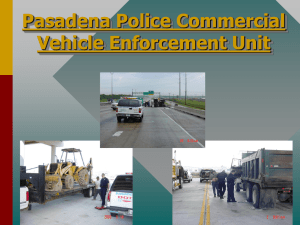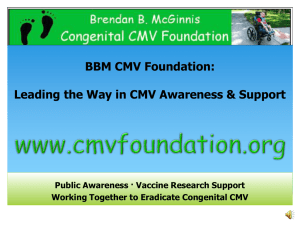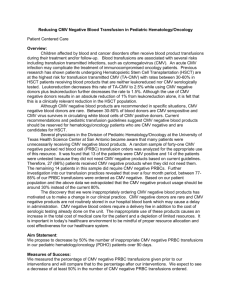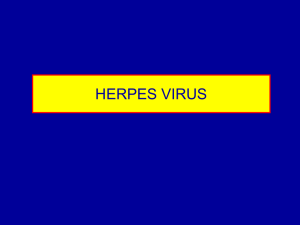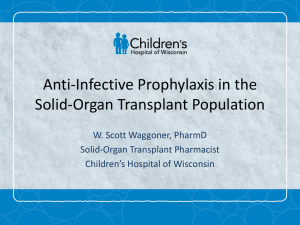CMV colitis - Advances in Inflammatory Bowel Diseases
advertisement
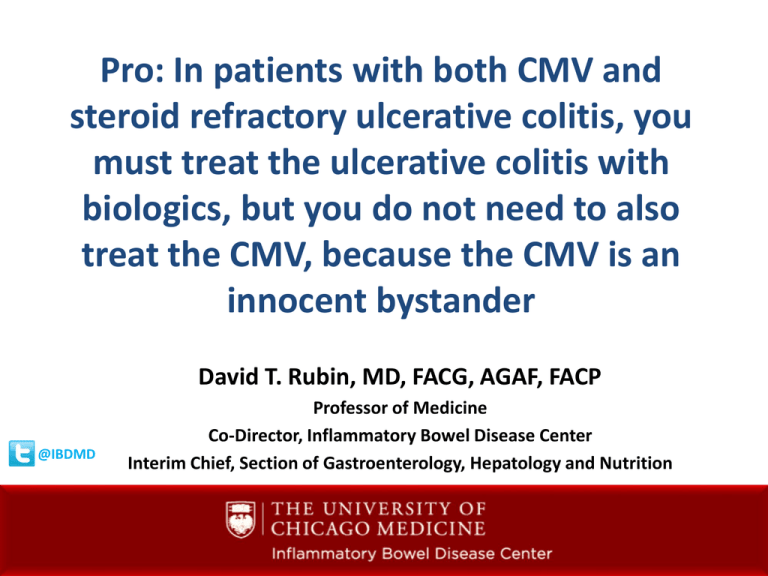
Pro: In patients with both CMV and steroid refractory ulcerative colitis, you must treat the ulcerative colitis with biologics, but you do not need to also treat the CMV, because the CMV is an innocent bystander David T. Rubin, MD, FACG, AGAF, FACP @IBDMD Professor of Medicine Co-Director, Inflammatory Bowel Disease Center Interim Chief, Section of Gastroenterology, Hepatology and Nutrition Innocent Bystander Innocent bystander: a viewer, watcher, onlooker, a guiltless witness of a crime. http://en.wikipedia.org/wiki/Innocent_bystander accessed December 12, 2013 CASE: 18-year old with CMV and UC • An 18 year old man was admitted to the Billings Hospital of the University of Chicago. • Presents with progressive severe bloody diarrhea for the for 2 months. • Stool and rectal swab were negative for parasites, ova and pathogenic bacteria. • Proctoscopy revealed “beefy-red” friable rectal mucosa. CASE: 18-year old with CMV and UC • Treatment with dextrose, electrolytes, penicillin, streptomycin and hydrocortisone did not result in improvement. ACTH treatment resulted in gradual improvement. • However the patient deteriorated and necessitated surgery on the 65th hospital day. An 18-year old with CMV and UC • Bx: cellular inclusions, typical of cytomegalic inclusion disease together with superficial inflammation of the colonic mucosa. • Diagnosis: CMV + Ulcerative colitis Powel RD, Warner NE, Levine RS, Kirsner J B. Am J Med. 1961;30:334-40. “We are unable to say whether the primary disease was UC or salivary gland virus (CMV) infection resulting in a clinical picture simulating UC.” Powel RD, Warner NE, Levine RS, Kirsner J B. Am J Med. 1961;30:334-40. Overview 1. “Having CMV” is not the same as CMV disease. 2. The presence of CMV may not require therapy for CMV in UC. 3. No evidence that biologic therapy make CMV colitis worse. 4. If biologics made CMV worse and CMV is often a bystander, we would expect to see much worse CMV colectomy rates or refractory colitis (and we don’t) 1. “Having CMV” is not the same as CMV disease Infection: • CMV antigens or antibodies in blood. Disease: • Symptomatic end-organ detection (clinical symptoms and tissue damage). CMV colitis: • Presence of the virus in the colon in sites of inflamed tissue. Lawlor G, Moss AC. Inflamm Bowel Dis. 2010;16:1620-1627. Kojima T, et al. Scand J Gastroenterol 2006;41(6):706-11. Lawlor G, Moss AC. Inflamm Bowel Dis. 2010;16:1620-1627. Kandiel A, Lashner B. Am J Gastroenterol. 2006;101(12)2857-65. Epidemiology of CMV in Inflammatory Bowel Disease • Prevalence of CMV infection is about 70% (similar to the general population). • Prevalence of CMV disease per test modality in severe colitis: – Serological tests+rectal biopsies around 20% – Antigenemia 34% – Histology +immunohistochemistry 3% • Prevalence of CMV disease per test modality in severe steroidresistant colitis: – – – – Histology 0.5% Histology + antigenemia 20-40% Blood PCR 60% Colon PCR 38% Garrido E et al. World J Gastroenterol. 2013; 19(1):17-25. Diagnostic Guidelines for Diagnosis of CMV Colitis 2010 - American College of Gastroenterology (ACG)1: • Sigmoidoscopic biopsy and viral culture in refractory colitis. 2009 - European Crohn’s and Colitis Organization (ECCO)2: • Tissue findings or Immunohistochemistry for CMV in immunomodulator-refractory IBD. 1. Kornbluth A et al. Am J Gastroenterol. 2010;99:1371-1385. 2. Rahier JF et al. J Crohn’s Colitis. 2009;3:47-91. Transplantation guidelines on Diagnosis of CMV • Histology/immunohistochemistry preferred method for diagnosis of tissue-invasive disease. • Viral culture of blood or urine has limited role for the diagnosis of disease. • Culture and QNAT* of tissue specimens have a limited role in the diagnosis of invasive disease but may be helpful in gastrointestinal disease, where blood QNAT may not be positive. *Quantitative nucleic acid amplification test (QNAT) Camille KN et al. Transplantation Journal. 2013;96(4):333-60. Prevalence of CMV in Biopsies of SteroidRefractory Colitis Study H&E IHC PCR Cottone et al, 2001 36% 36% - Domenech et al, 2008 26% 32% 42% Kambham et al, 2004 5% 25% - Minami et al, 2007 17% - - Yoshino et al, 2007 3% 6% 57% H&E; Hematoxylin & eosin; IHC, immunohistochemistry; PCR, Polymerase chain reaction. Adapted from Lawlor G, Moss AC. Inflamm Bowel Dis. 2010;16:1620-1627. 2. CMV is Frequently Reactivated and Disappears Without Antiviral Agents in UC Patients Methods: • Prospectively followed 69 moderate-severe (steroidrefractory) UC patients with positive CMV IgG or IgM for 8 wks. (on steroids and immunosuppressants) Results: • ~79% of patients had reactivation of CMV (antigenemia and PCR). • Reactivation resolved in all patients at 10 wks WITHOUT THERAPY • Outcome: (+) CMV and (-) CMV had similar remission and colectomy rates. Matsuoka K et al. Am J Gastroenterol. 2007;102:331-337. CMV in the Colon is Not Associated with a Higher Disease Activity or Colectomy Rate (+) CMV-DNA (n=17) (-) CMV-DNA (n=13) P-Value 9.8 ± 1.2 9.2 ± 1.6 0.206 0 (0) 1 (7.7) 0.245 - Left-sided 4 (23.5) 3 (23.1) 0.977 - Pancolitis 13 (76.5) 9 (69.2) 0.657 Endscopic DAI score 2.4 ± 0.7 2.1 ± 0.6 0.194 Matts grade 3.1 ± 0.8 2.9 ± 0.8 0.687 Endoscopic index of Rachmilewitz 9.5 ±2.4 8.8 ± 2.4 0.444 Colectomy rate 5 (29.4) 1(7.7) 0.196 DAI-Score Extent of disease - Proctitis Not Significant DAI= Disease Activity Index Yoshino T et al. Inflamm Bowel Dis 2007;13(12)1516-21. 3. No evidence that biologics (anti-TNF) make CMV colitis worse (In fact, it’s the opposite) Infliximab Does Not Reactivate CMV • Active CMV infection DOES NOT progress to disease following infliximab therapy in UC or CD. 1,2 • Active Crohn’s disease and CMV + serology (IgG) (n=42) developed a CMV + PCR when treated with infliximab in 14 weeks.2 1. D’Ovidio V et al. J Clin Virol. 2008;43(2):180-3. 2. Lavagna et al. Inflamm Bowel Dis. 2007;13:896-902. 4. If biologics made CMV worse and CMV is often a “bystander,” we would expect to see much worse CMV in colectomies or in refractory colitis (and we don’t) CMV findings in colectomy specimens Italy1: UC proctocolectomy cohort of 77 patients • 21% (16) were CMV (+) on surgical specimen • 15/55 CMV(+) in steroid-refractory UC • NONE of the patients required antiviral therapy during followup • Japan2: UC proctocolectomy cohort of 126 patients • Only 11% (14) were CMV (+) on immunohistochemistry staining 1. 2. Maconi G, et al. Dig Liver Dis 2005;37(6):418-23. Kojima T, et al. Scand J Gastroenterol 2006;41(6):706-11. Treatment Algorithm CMV in UC Steroid refractory colitis CMV antigens or antibodies in serum CMV detected in biopsies Clinical symptoms + Tissue damage CMV Infection CMV Colitis CMV Disease Treat CMV with Anti-viral Treat the ulcerative colitis Conclusions 1. “Having CMV” is not the same as CMV disease. 2. Whether CMV is present or not doesn’t change the need for CMV therapy in UC. 3. There is no evidence that biologics (anti-TNF) make CMV colitis worse. 4. If biologics made CMV worse and CMV is often a bystander, we would expect to see much worse CMV colectomy rates or refractory colitis (and we don’t). Therefore: We must treat the colitis and distinguish CMV infection from CMV disease. Russell Cohen, MD David Rubin, MD Sushila Dalal, MD Joel Pekow, MD Stacy Kahn, MD Barbara Kirschner, MD Rajana Gokhale, MD Eugene Chang, MD John Kwon, MD, PhD Bana Jabri, MD, PhD Sonia Kupfer, MD Jerrold Turner, MD, PhD John Hart, MD Shu- Yuan Xiao, MD, PhD Michele Rubin, APN Jennifer Labas, APN Alana Wichmann, APN Ashley Bochenek, APN Roger Hurst, MD Konstantin Umanskiy, MD Mukta Krane, MD Mustafa Hussain, MD Vivek Prachand, MD Arunas Gasparaitis, MD Abraham Dachman, MD Sarah Goeppinger Ruben Colman, MD Dylan Rodriquez Administrator: Anna Gomberg Britt Christensen, MD Veena Nannegari, MD Mary Ayers, RN Linda Kulig, RN Debbie James, RN Vallary Armstrong-Jones, RN Sharon Bogan-Bell, RN Rose Arrieta, RN Kristi Milam, RN Tracy Shumard, RN Lori Rowell, RD Elizabeth Wall, RD
